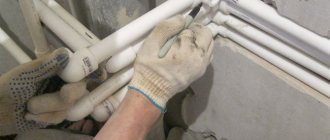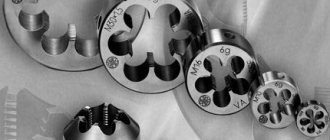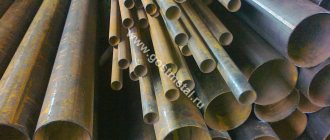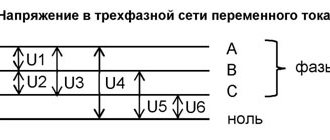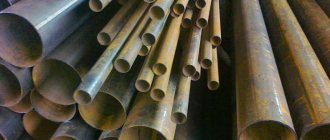Any kitchen includes several types of pipelines: heating pipes and radiators, sewer, gas, water, and ventilation pipes. There are many ways to disguise these communications. Some of them are quite simple and do not require large financial and labor costs, while others are more complex. In any case, each owner can choose the appropriate method that will help disguise various communications in the kitchen.
You can disguise communications in the kitchen in different ways, using wall decoration and furniture
Why disguise pipes in the kitchen?
The abundance of communications in the kitchen, as a rule, spoils the appearance of the room. And the kitchen is a place where not only the owners, but also guests often gather, so masking pipes in this room is a common problem. This problem can be solved using different methods. Let's look at the most common options for hiding a pipe in the kitchen.
Option for masking pipes in the kitchen
The easiest way is to decorate water and sewer pipes, since there are special sleeves for this. In addition, you can use the box, placing it under the sink. Pipes located in such boxes are hidden from prying eyes and are always freely accessible for repair or modification work.
Note! Experts do not recommend laying water and sewer lines using a hidden method (in the walls). This is due to the fact that when they leak, it is much more difficult to determine the location of the breakdown, and their repair requires dismantling the wall.
Don’t forget about the heating radiator, which can rightfully be considered the most noticeable part of the heating communication in the kitchen. There are a lot of options for masking and decorating batteries - from ordinary painting to a full-fledged wooden cabinet installed end-to-end on the windowsill, resulting in a small pantry in which you can store various kitchen utensils.
Masking a gas pipe using a special box
Gas pipes must not be laid in a closed manner. Therefore, their camouflage is carried out by installing special boxes, as well as using various decorative methods.
What do the regulations say?
Before making a decision regarding camouflage of a gas pipeline, you need to understand the requirements regarding the operation of such pipes in a private house or city apartment. This is what the legal acts say:
- The user must ensure unobstructed access to the lines to eliminate gas leaks and carry out repairs. Failure to comply with such standards can cost human life.
- It is forbidden to close the pipe tightly, for example with a box. This will allow fuel to accumulate, which will ultimately increase the likelihood of an explosion. It is not recommended to hide utility lines in the wall structure. To do this, you need to use decorative ventilated products.
- It is prohibited to replace pipes and other elements of the gas pipeline yourself. This must be done by a qualified specialist.
- Pipelines need to be painted. A layer of paint prevents metal corrosion and extends the life of the pipeline.
- Do not hang heavy objects on the pipes or try to repair them in the event of a breakdown or gas leak.
When carrying out repair work, be sure to turn off the supply valve. Do not try to make the kitchen interior ideal; when choosing decor, follow the recommendations of a gas specialist.
Masking the plumbing and heating system
If you nevertheless decide to install pipes related to the plumbing and heating system using a hidden method, then it is recommended that the pipes in these pipelines be permanent connections. This reduces the risk of an emergency.
Hidden installation of communications is carried out in special channels (grooves). This method is complex and requires a lot of labor, as well as care and precision, so it is best to call a specialist for hidden installation of pipelines who is able to carry out high-quality and reliable installation of pipes in the walls.
First of all, let's look at how to close the pipes in the kitchen that transport hot or cold water. Most often, hidden installation is used to disguise heating and plumbing systems. Its essence lies in laying pipes in wall channels (grooves).
Laying pipes in wall channels
If you have the necessary equipment (a hammer drill with attachments), then you can make the grooves yourself. Let's look at the step-by-step installation of water supply lines in the wall:
- First, it is necessary to dismantle the old pipeline structure.
- Next, a diagram of the future wiring is applied to the walls using a marker.
- After this, it is necessary to drill channels for the future pipeline structure. The channels must be made according to the markings, and the width and depth of the grooves must take into account the width of the pipeline in the thermal insulation. In addition, it is necessary to leave a small reserve for cement mortar, with which the channels will be sealed.
- At this stage, the finished grooves are cleaned of dust and other small particles, after which pipes are laid in them. To secure pipeline elements in the channels, special brackets or brackets are used.
- After installing the communication, it is recommended to test run it. This will allow you to identify possible leaks and eliminate them before sealing the walls. If the pipeline functions without flaws, then work can continue.
- At this stage, the installation of thermal insulation material is carried out. It is convenient to use special covers as a heat insulator, which are made from different materials and are easy to install.
- At the end, the pipes in the channels are sealed with cement mortar.
Note! Sewer pipes can also be laid in grooves, however, this is much more difficult due to the fact that the channels for the elements of this communication must be wider and deeper.
Masking sewer pipes in the kitchen in grooves
Elimination of deficiencies according to the rules
Despite many restrictions, masking gas communications is possible if all the rules are taken into account. It's nice that there are several options for eliminating the problem.
Gas pipe transfer
If the complex shape of the gas pipeline does not fit into the concept of the future design at all, the apartment owners may decide to move the gas pipe; The service is provided by the gas service. A transfer project is pre-developed, which takes into account existing standards (primarily) and the wishes of the owners.
Using a chrome table leg Source ad-cd.net
A significant disadvantage of this method is the time required. The development of the project will take from one to three weeks; Several days pass after the application is submitted and the installation team arrives, but the transfer itself is completed within a day.
Unfortunately, not every structure will be allowed to be moved, and the project will not always suit the owners. But, in any case, the pipe will have a more neat appearance, which will allow it to be disguised in the future.
When the pipe fits into the interior Source i.pinimg.com
How to hide pipes in the kitchen? Tips for concealed installation of water pipes
There are several important rules for hidden installation of communications that are worth paying attention to:
- Only new pipes are allowed to be laid in grooves. Old pipelines must not be installed in walls;
- if the communication is made of plastic and is intended for heating or transporting hot water, then it is imperative to install special compensators. Compensators are needed to cope with the thermal expansion of pipes. For example, polypropylene products are capable of expanding under high temperature up to 5 mm per 1 linear meter;
- if the communication is mounted using detachable connecting fittings, then free access to them must be provided.
Masking heating pipes in the floor
To disguise pipes related to heating communications, their hidden installation in the floor is often used. If the floor is made of wood, then the pipeline is laid between the bars (joists).
If a concrete floor is to be poured, then the pipeline structure is laid directly into the screed. Before laying it, it is recommended to make sure that the communication is working by checking it for leaks.
Masking heating pipes in the floor
A pipeline laid in the floor, like a plumbing system installed in the same way, needs high-quality insulation. A heat insulator is necessary to ensure that heat does not dissipate along the concrete screed. Without good thermal insulation material, the heating system in the floor will waste a lot of energy heating the screed.
The places where the pipeline exits the floor are usually covered with special covers, which makes it possible to hide the pipes. Overlays can be selected in various structures, shapes, etc.
How to close gas pipes in the kitchen?
Many owners are interested in the same question: how to hide a gas pipe in the kitchen? Installation of such a pipe in the wall, as mentioned above, is prohibited, however, there are several ways in which you can close a gas pipe:
- using a special box;
- run pipes inside the cabinet;
- decoration.
Masking a gas pipe in the kitchen using a box
Today, the most popular option for masking gas pipes is to install a special plasterboard box around them. In addition, it is worth noting that such boxes are also used for other communications in the kitchen: heating pipes, ventilation pipes, etc.
Let's look at the list of materials that will be needed to install such a box:
- metal profiles;
- drywall;
- putty;
- self-adhesive mesh.
It is worth noting that, if desired, you can make the box from other materials, but it is much easier to work with drywall. Let's consider the materials from which a pipeline box can be made:
- plywood;
- chipboard (chipboard);
- plastic.
A plasterboard box is one of the most popular solutions for masking pipes
Let's look at the installation of the box step by step:
- First of all, it is necessary to mount the frame of the box from a metal profile.
- Next, the finished frame is lined with plasterboard. Self-tapping screws are usually used to secure plasterboard sheets.
- At the end, the chamfers are removed from the edges of the drywall, after which it is necessary to glue the reinforcing mesh and putty it.
Important! In order to disguise the riser using a plasterboard box, you need to use racks connected to each other by jumpers. Such racks will be the basis of the structure. Special guides are installed on the floor and ceiling. Installation of a horizontal box is carried out in the same way, however, it has one difference - two guides are fixed on the floor. Dowels are used to attach the profile to the wall.
The installation of the plastic box is carried out in the same way as in the previous case, however, there are some differences. For example, the joints and outer corners of the structure are covered with decorative corners made of a similar material.
Plastic box for masking pipes in the kitchen
Other types of boxes
In addition to plasterboard, there are other types of cladding, in particular PVC or MDF panels. Their main advantage is ease and simplicity of installation and, if necessary, dismantling. The frame is made of a small-section wooden beam, to which a plastic profile for the panels is glued or screwed.
The longitudinal edges of the panels have special grooves - they easily fit together and are disassembled. The result is an easily removable structure that covers any risers and pipes, including gas ones.
The only negative is that such a box is not suitable for every interior.
The wooden frame is sheathed with plywood, fiberboard or other sheet materials. Despite the fact that such designs are now considered somewhat outdated, they regularly perform their functions. After all, under the wallpaper you can’t see what the box is made of.
Masking other pipes
Ventilation pipes coming from exhaust equipment can be hidden using various methods. The simplest option for hiding pipes related to the ventilation exhaust system is to lay them on the wall above the wall cabinets. This method is especially popular if the exhaust pipes have a rectangular cross-section. In this case, the cabinets will ideally hide the communication adjacent to them and the wall.
In addition, a simple and quick option for masking any communication is to purchase a ready-made bedside table without a back wall. Using this design you can hide water and sewer pipes. However, a significant disadvantage of this method is the high cost of new furniture produced to order.
Small cabinets or cabinets can be made with your own hands. To do this, you will need to purchase a pre-calculated amount of material. As a rule, chipboard or MDF is used to assemble such cabinets and cabinets.
Cabinet for hiding pipes in the kitchen
From a constructive point of view, making such a cabinet is quite simple. It consists of two side walls and a front door. This camouflage option is considered very convenient. This is due to the fact that this method provides free access to all connecting elements of the pipeline, as well as to shut-off valves.
How to hide a pipeline behind a kitchen facade
Kitchen furniture allows you to disguise horizontal and vertical sections of pipelines, as well as some gas equipment, for example, dispensers or meters. It is better to install a kitchen façade during renovation work; to do this, order a false cabinet of the required size or modernize existing furniture.
The main condition for such camouflage is considered to be sufficient ventilation of the space, which will prevent the accumulation of gas during a leak. To do this, several holes are made in inconspicuous places, but they should not be blocked by pots or jars. The ideal way out of the situation would be to install a grille. Vertical pipes are usually hidden in a pencil case, and horizontal pipes are placed in a cabinet. The main condition for such camouflage is unhindered access to utilities.
Battery screen
In order to hide the heating radiator in the kitchen, special screens are often used. If desired, you can make the screen for the battery yourself, since this design is not very complicated. Such a screen will not only cover the radiator, but will also become another shelf for you.
The screen for the heating radiator differs in that it has a lattice structure. This quality allows heat to freely enter the room and warm it. Such screens are made from different materials:
- tree;
- plastic;
- metal.
Wooden screens for heating radiators have one significant drawback - wood absorbs moisture from the room and evaporates it due to its location next to the radiator. Subsequently, this leads to deformation, cracks and blisters on the wooden surface.
Wooden screen for heating radiator
Plastic structures are inexpensive, but when exposed to high temperatures, they emit various harmful substances that can harm human health.
Metal screens do not deform, have fairly good resistance to mechanical stress, and also have a high heat transfer coefficient. The surface of such screens is painted using high quality powder paint. Over time, this paint does not darken, which is a very important advantage.
Railing is a functional way to disguise pipes in the kitchen
Using this method allows you to visually camouflage the pipe. In English, “rail” is translated as “crossbar”. This masking option does not involve closing communications. In this case, the pipeline is considered as a functional element of the kitchen and is used as a crossbar, disguised with various kitchen accessories (towels, pepper shakers, ladles, etc.).
It is worth noting that it is important to correctly calculate the capabilities of the pipeline - if you place too many devices on it, the structure may not withstand it. Experts recommend further strengthening the pipeline structure before performing this method.
Railing is a functional way to disguise pipes in the kitchen
Let's consider step by step this non-standard option for masking the pipeline:
- First, you need to clean the pipe until it shines (if the pipe is old).
- Next, the pipeline must be painted in a color that matches the interior of the kitchen.
- After the pipe has dried, you can apply an additional layer of varnish.
- Special hooks are installed on the resulting pipe.
- At the end, the necessary accessories are placed on the hooks.
Decor options
It often happens that pipes run along the wall along the entire length of the room or are located in the kitchen apron area. You may also need to hide the battery or decorate the riser in an interesting way using suitable decor.
There are several options for interior solutions:
- If pipes pass in close proximity to the work area, then the best decor for them is a railing system. Railings are a hanging system with many different shelves, hooks and necessary kitchen accessories. To turn the riser into a railing, it must be thoroughly cleaned and painted with paint that imitates stainless steel. Then the necessary devices are placed near the pipe - do not forget that you cannot hang anything on the communications.
- The battery and pipes can simply be painted to match the color of the walls.
- A thick pipe can be decorated with interior mosaics or artistic painting.
- You can entwine the structures with artificial flowers, rope, multi-colored threads - it all depends on the style of the kitchen.
- A nice option will turn out if you use decor using the decoupage technique. You can choose any motif that matches the existing interior, and also make the surface shiny or matte.
- This way you can also decorate the radiator - it is clear that the work should not be carried out during the heating season. The order of work here is as follows: first, the pipe is protected and carefully painted, after which a napkin with the chosen motif is glued to PVA. After the napkins dry, the resulting pattern is covered with a layer of special varnish.
